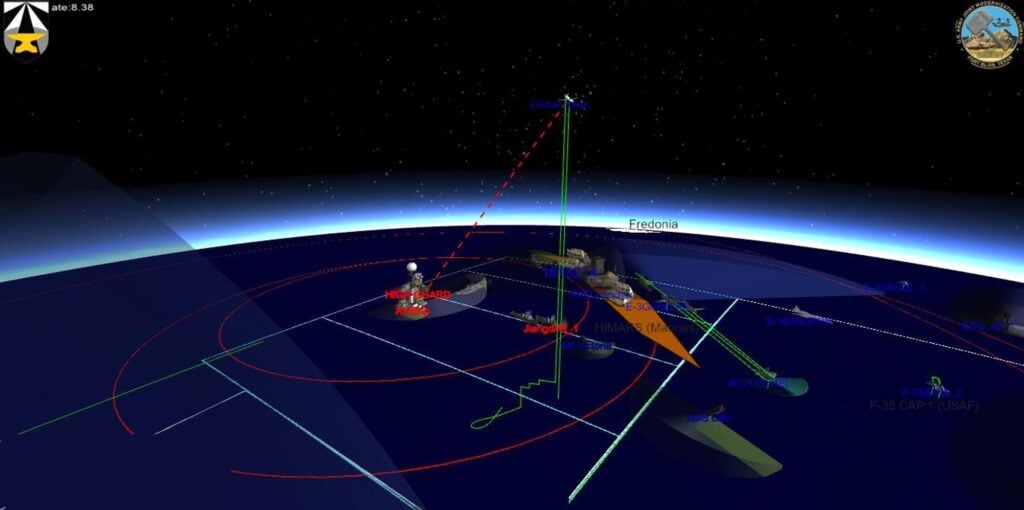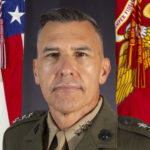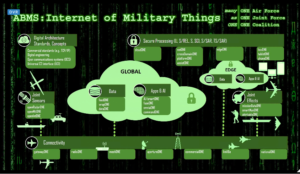
The Joint Staff’s Joint All-Domain Command and Control Campaign Plan Experiment 2 allowed Army, Navy, Air Force and Marines to share information and display it as a common operational picture.
WASHINGTON: The Joint Staff has called an all-hands-on-deck conference for the end of the month to hash out common data standards for future Joint All Domain Command and Control (JADC2) operations, says Marine Corps Lt. Gen. Dennis Crall, head of the J6.
“We’re going to tackle that at the end of January in a conference [where] we’re bringing together all of the folks who have a vested interest and we are going to attempt to settle this, or at least bring in some courses of action that we can use … in the department to have our senior leaders make decisions,” Crall, who in his role is leading the Joint Staff effort to develop a JADC2 strategy, said in an exclusive interview.
“One thing we can’t repeat is what we’ve done in the past,” he stressed. “There’s a couple of words that are trigger words for me, because they really don’t mean what they say. Standards, in many cases, provide everything but standards. Interoperability is a word normally tagged on something that is not interoperable. We just have a sordid history of not really delivering … We’ve published standards that people can drive trucks through; they’re just not meaningful, and people can comply and just wreak havoc in areas.”
Crall explained that, without real standards that corral how the services pursue new C2 software and systems, the entire edifice of JADC2 — which Crall defines as the decision-making process that will all commanders to manage future All Domain Operations — will fall apart.
“If we pay lip service to this, and meet and come up with yet another ‘standards-based’ loose thing, we will not make any progress against this entire endeavor. We will not be able to implement the tougher pieces, and we certainly won’t be able to inform the new things that should come online,” he stressed. So, we have a do or die moment coming for us here at the end of January; there’s a lot riding on this conference.”
The JADC2 “data summit” will bring together officials from DoD agencies, the services, Department of Homeland Security and even NATO, Crall said, with an eye to “setting tolerances” on how data standards are built and implemented so “they’re not so wide they’re unusable because they sound like platitudes or principles, but not set so narrow that we’re delivering single-source or single-threaded solutions.”

Lt. Gen. Dennis Crall
As Sydney reported back in October, DoD meanwhile has published a top-level “Data Strategy” focused on future capabilities. As a first step, DoD’s Chief Data Officer Council will create a common vocabulary and common metrics for performance. The strategy will also guide requirements and standard-setting going forward. The Joint Requirements Oversight Council (JROC) will be insisting on open software standards to ensure cross-service and cross-domain compatibility so that as new subsystems, like radar or fuzes for warheads, come on line, they can all be linked through common software interfaces.
Crall said the overall goal is development of a “common data fabric” for JADC2 that “incorporates everything from standard definitions to the way it’s employed to the way that we modernize it … It is no small task. We could have started out with something less ambitious, probably easier to deliver. But that is where we need to be.”
A common data fabric refers to a set of standards and IT services that allow data to be shared among different weapon systems, different C2 networks, different organizations and services and across different levels of security.
The J6, Crall said, is looking to academia, DoD labs and industry for help in stitching current C2 systems together and avoiding vendor lock in future. “What are these future and emerging systems going to look like to make sure that we’re doing software properly and that we solve things like identity management — all prerequisites to on-boarding cloud and AI-based capability that we so desperately need?”
Despite having “some very difficult challenges to broker,” Crall said he is confident the JADC2 effort will be able to deliver actual capabilities within “this life-cycle” under the Pentagon’s five-year Program Objective Memorandum (POM) and budget.
“One of the confusing aspects of this has been a narrative, which is not accurate, that somehow JADC2 will deliver in a decade — as though we’re going to build this, and then we’re going to run silent, and then 10 years from now we’re going to emerge with all this capability,” he said. “That is furthest from the truth. JADC2 will begin delivering immediately in some areas, because we’re very close to closing some of those deliverables right now.”
While Crall did not elaborate on what those near-term deliverables might be, he did say that ongoing work by the services and Combatant Commands has helped provide “a head start.”
“The good news is the services — who are largely responsible for some key elements of this — have some of those already built into their POMs, which are they’re executing already,” he explained. The role for the J6 is avoiding a situation where there are “five very similar startups” rather than one that could be leveraged by all. “So getting that captured — where we can share resources and we can share output — is going to be critical.”
And in order to rapidly field new capabilities, he added, DoD will be using “everything from mid-year reprogramming to end-of-year money, where it makes sense. We’ll be looking at near-term, midterm and long-term,” he said.
Crall further stressed that — despite some past confusion, in large part because different stakeholder communities have been using slightly different definitions of JADC2 — there is no single service responsible for JADC2. “JADC2, with its strategy and posture review, is a Joint Staff initiative,” he said.
As Breaking D readers know, the Air Force for the past year has staked out a lead role in developing the JADC2 concept — in particular, focusing its Advanced Battle Management System (ABMS) on the technologies needed to create a “military Internet of Things” as the scaffolding for JADC2 operations.
“I think it’s important to know the Air Force’s role and that they’ve been very helpful. The Air Force has been given the lead for JCC2,” Crall said, which is a nested acronym for Joint Warfighting Concept Command and Control. As Breaking D readers know, Chairman of the Joint Chiefs of Staff Mark Milley tapped the Air Force, Army and Navy to lead development of one of four sub-elements of the Joint Warfighting Concept. The concept is aimed at laying how how the military will actually fight battles linking sensors and shooters across all five domains — air, land, sea, space and cyberspace.
 “Some in the department have viewed ABMS as kind of a precursor and a forerunner to that sensor-shooter analogy. But if you look at JADC2 the way I described it, there is no single service responsible for JADC2, Crall said.
“Some in the department have viewed ABMS as kind of a precursor and a forerunner to that sensor-shooter analogy. But if you look at JADC2 the way I described it, there is no single service responsible for JADC2, Crall said.
Despite past grumbling — particularly by the Army — about who’s on first in building systems for implementing JADC2, Crall took pains to stomp down talk of competition.
“Some have tried in the past to view this almost as a competition, right?” he said. “You’ve got the Air Force working on their thing; the Army and the Navy [on theirs] and the question becomes, ‘who’s in the lead for this — who’s going to grab this JADC2 trophy? And the answer is — we’re not in competition.”
That said, Crall noted that the Joint Staff effort to develop a JADC2 strategy needs to be finalized soon because if service initiatives are “unchecked” and are pursued in the absence of a “roadmap,” they “could end up in different grid squares, in competition on investments, money, standards and delivery timelines.” Fortunately, Crall said, the Joint Staff process for developing the JADC2 strategy and the JROC effort on requirements are “far enough to the left” that “if we bring folks together and the way that we’re positing, I think we’ll find ourselves landing in a really good spot.”






















